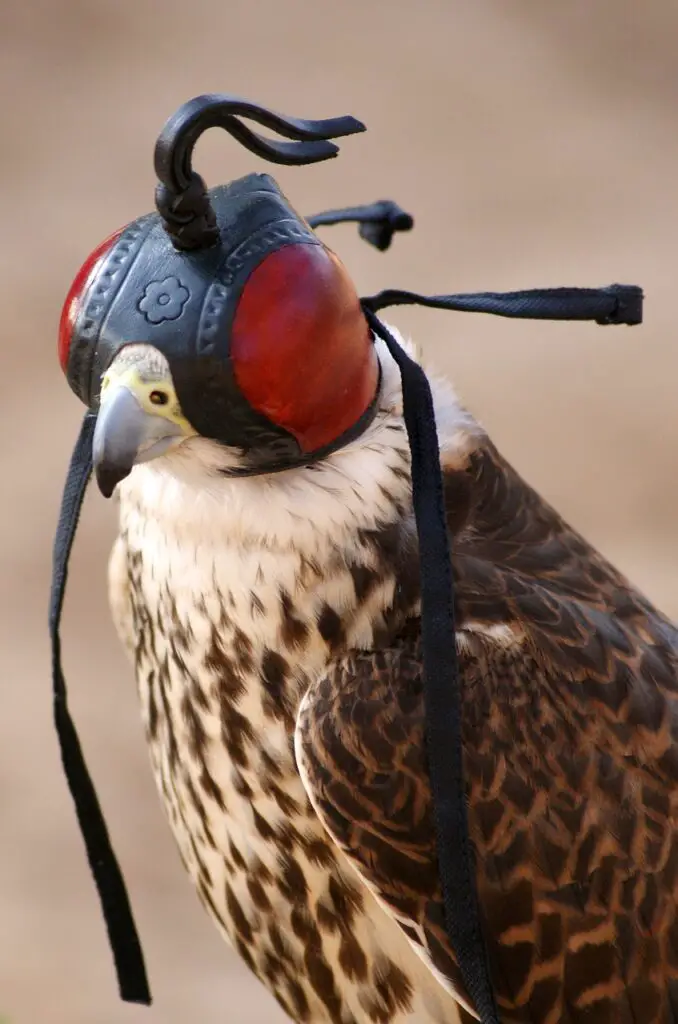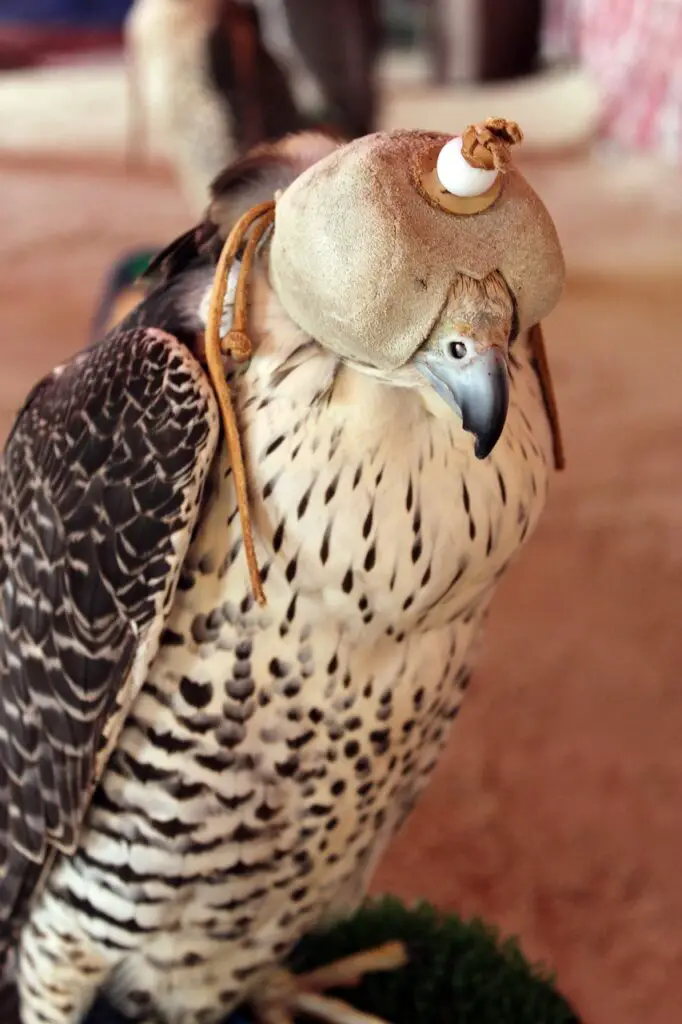Hoods are an important part of any falconer’s day-to-day use. These specialized hoods play a crucial role in the training and handling of falconry birds, but there is much more to them than meets the eye. From different types of hoods to finding the perfect fit for your bird, there is a wealth of information to uncover. So, if you’ve ever wondered about the intricacies of falconry hoods and their significance, keep reading to discover the full guide on this subject.
Why are falconry birds hooded?
Falconry birds are hooded to provide them with a sense of security and comfort during transportation and rest. The history of falconry hoods dates back centuries, demonstrating their importance in this ancient practice. Hooding offers numerous benefits, including reducing stress levels and preventing distractions. Although alternatives to hooding exist, such as using blinders or training birds without hoods, falconry hoods’ cultural significance and effectiveness make them a preferred choice.

Types of falconry hoods
Several types of falconry hoods are commonly used. These include the Dutch hood, the Anglo-Indian hood, and the Arabic hood. Each type has its own unique design and purpose, providing different levels of protection and visibility for the bird.
Dutch hood
The Dutch hood, a commonly used type of falconry hood, is designed to provide a secure and comfortable fit for the bird, ensuring optimal control during training and hunting sessions. It has been used for centuries and is still favoured by many falconers today. While there are alternatives to the Dutch hood, its benefits include its ability to block the bird’s vision, reducing stress, and preventing distraction.
Anglo-Indian hood
With its unique design and functional features, the Anglo-Indian hood is a popular choice among falconers for its effectiveness in training and protecting birds of prey.
- Anglo-Indian hood history: Developed during British colonial rule in India, it combines traditional Indian craftsmanship with European falconry techniques.
- Anglo-Indian hood design: It features a longer, tapered face opening, providing better visibility for the bird.
- Anglo-Indian hood materials: Made from high-quality leather, it offers durability and comfort for the bird.
- Anglo-Indian hood controversy: Some falconers argue that it greatly restricts the bird’s vision.
Compared to other hoods, the Anglo-Indian hood stands out for its historical significance, unique design, and choice of materials. However, its controversial aspect regarding vision restriction should be taken into consideration when selecting a hood for falconry.
Arabic hood
Moving on from the discussion of the Anglo-Indian hood, let’s now explore the Arabic hood, another significant type of falconry hood. The history of Arabic hoods in falconry dates back centuries, with their origins in the Middle East. These hoods are known for their unique design features, including a long, pointed brim and a large eye slit. Compared to other types of falconry hoods, Arabic hoods offer advantages such as better visibility and airflow, but they may also have limitations depending on the specific falconry needs. Additionally, Arabic hoods hold cultural significance in falconry traditions, representing the rich heritage of the Middle East.

How to find the right size hood for your bird
To ensure a proper fit for your bird, accurately measuring its head size is crucial when selecting a falconry hood. Here are the key points to consider:
- Hood sizing techniques: Use a soft measuring tape to measure the circumference of your bird’s head, just above the eyes.
- Factors to consider when choosing a hood size: Take into account the species, age, and sex of your bird, as well as its head shape and size.
- Tips for measuring your bird’s head for a hood: Measure several times to ensure accuracy, and record the measurements in centimetres.
- Common mistakes to avoid when selecting a hood size: Don’t rely solely on guesswork or estimates, as an ill-fitting hood can cause discomfort and hinder the bird’s performance.
- How to properly adjust a hood for a perfect fit: Use the adjustable straps to snugly fit the hood around the bird’s head, ensuring it is not too tight or loose.
What is a falconry hood block?
After accurately measuring your bird’s head size, the next step in selecting a falconry hood is understanding what a falconry hood block is. A falconry hood block is a wooden or plastic mould that shapes and forms the hood materials into the desired design. It is an essential tool in the process of creating falconry hoods, allowing for precise shaping and ensuring a proper fit for the bird.
What is a falconry hood protector?
A falconry hood protector is an essential accessory that helps to safeguard the falconry hood from damage and maintain its shape during storage and transportation. Here are four key reasons why a falconry hood protector is important:
- Protection: The protector shields the hood from scratches, tears, and other forms of damage, ensuring its longevity.
- Shape maintenance: The protector helps the hood retain its proper shape by providing structural support.
- Easy training: A well-maintained hood allows for efficient training by providing a comfortable and secure fit for the bird.
- Customization: Some protectors also offer options for customization, allowing falconers to personalize their hoods with colours or patterns.
Taking care of your falconry hood is essential to ensure its longevity and effectiveness in falconry training. A falconry hood protector is designed to help with this task. Made from durable materials, these protectors shield the hood from damage that can occur during storage and transportation.

What are falconry hood braces?
Now, let’s explore the functionality and importance of falconry hood braces, an integral component in maintaining the shape and stability of the falconry hood. Falconry hood braces are specially designed fittings that help secure the hood in place, preventing it from slipping or shifting during flight. They play a crucial role in ensuring that the hood stays securely on the bird’s head, allowing for effective hood training techniques and minimizing distractions. When it comes to falconry hood braces, there are various material options available, including leather and nylon, each with its advantages and considerations.
Are falconry hoods cruel?
When used properly and with care, Falconry hoods are not considered cruel but rather serve as a valuable tool in the training and management of birds of prey.
- Ethical considerations: Falconry hoods are designed to minimize stress and protect the bird’s eyes, ensuring their well-being during training sessions.
- Alternatives to hoods: Some trainers opt for training without hoods, using other methods like positive reinforcement and tethering.
- Historical use of falconry hoods: Hoods have been used for centuries in falconry to calm and control birds during hunting.
- Training methods without hoods: Trainers can use techniques such as lure training and operant conditioning to achieve similar results without hoods.
- Impact on falcon behaviour: Properly used hoods have no long-term negative effects on falcons, as they adapt well and continue to exhibit natural behaviours.
In conclusion, falconry hoods play a crucial role in the training and protection of falconry birds. They provide the birds with a sense of security and calmness during transportation and rest periods. The right size hood, along with additional accessories like hood blocks, protectors, and braces, ensures the well-being and comfort of the birds. So, embrace falconry hoods as an essential tool in the art of falconry.
Frequently Asked Questions
Can Falconry Hoods Cause Any Harm or Discomfort to the Birds?
- Falconry hoods can potentially cause harm and discomfort to birds if not done properly. They may impact behaviour and pose health risks.
How Often Should Falconry Hoods Be Cleaned and Maintained?
- Falconry hoods should be cleaned and maintained regularly to ensure their effectiveness and longevity. I recommend cleaning them every few weeks using mild soap and water. Look for signs of wear and tear and store them properly to prevent damage.
Can Falconry Hoods Be Customized or Personalized?
- Yes, falconry hoods can be customized or personalized. This allows for a variety of customization options, such as choosing popular designs and selecting the right size for a custom hood.
Are There Any Alternative Methods to Hooding Birds in Falconry?
- Yes, there are alternative methods to hooding birds in falconry. Training techniques like positive reinforcement and operant conditioning can be used. Natural alternatives include using blindfolds or screens to limit vision.

